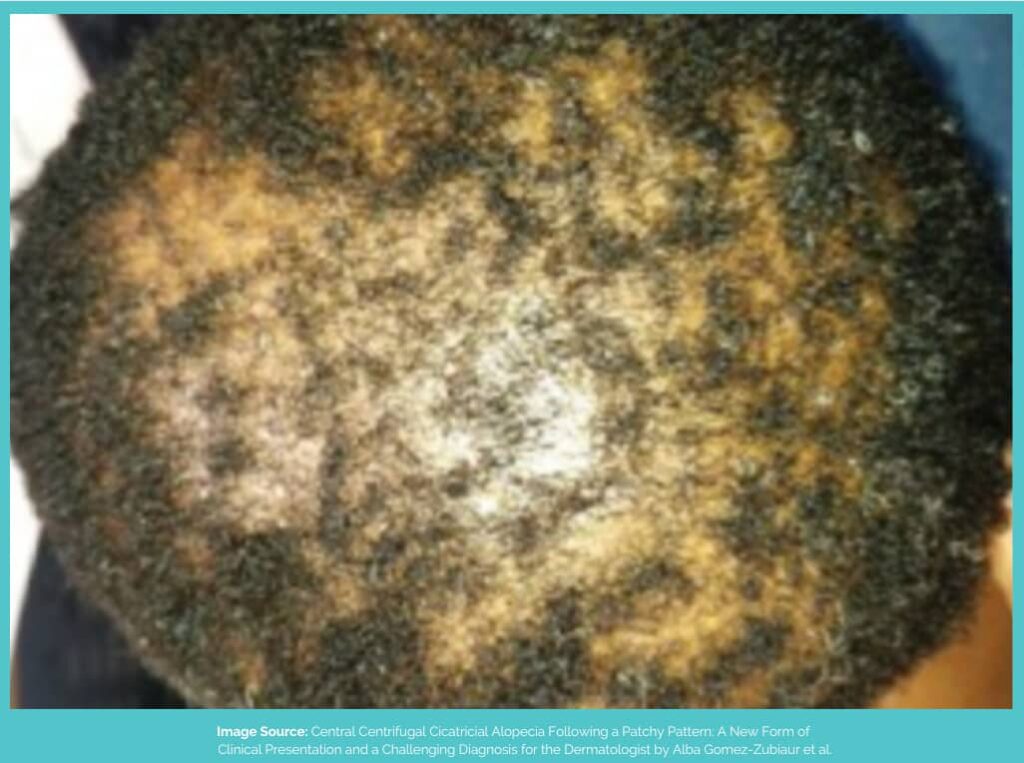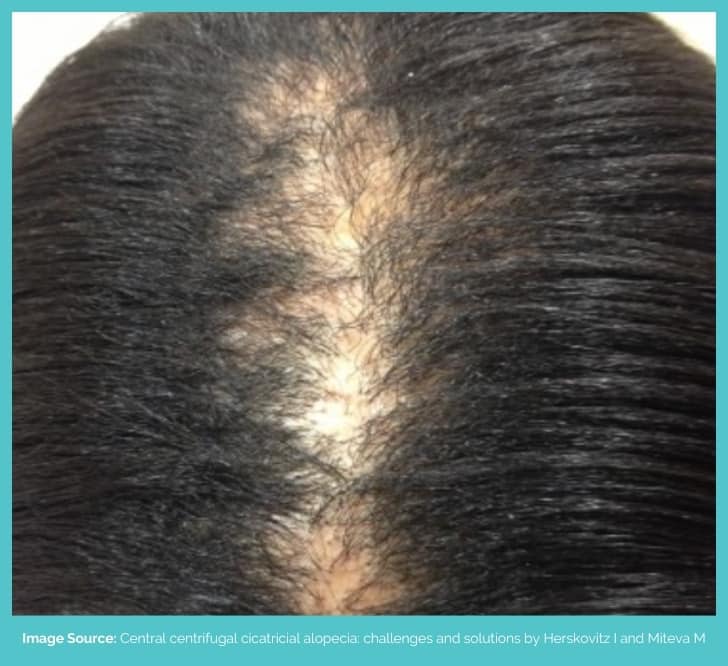Central centrifugal cicatricial alopecia is the most common type of scarring alopecia that leads to permanent hair loss.
It’s called “central centrifugal” because it affects the centre (crown/vertex) of the scalp and tends to spread in a centrifugal pattern – moving away from the centre. And “cicatricial” just means scarring.
Unfortunately, with this type of hair loss, you may not even realise that you’re losing your hair permanently. The progression can be “silent,” and when it’s finally diagnosed, it might be too late to regrow the hair.
It’s even confused with other types and causes of alopecia, such as pattern baldness in females, tinea capitis (fungal scalp infection) and lichen planopilars (another type of scarring alopecia).
What Is Central Centrifugal Cicatricial Alopecia?
Central centrifugal cicatricial alopecia (CCCA) is a type of primary scarring alopecia in which hair follicles are destroyed as a result of inflammation.

It was first described in 1968 as “hot comb alopecia.” The study published in the Archives of Dermatology investigated crown hair loss in 51 African American women who used a hot comb with petrolatum (i.e. petroleum jelly) to straighten their hair.
Their hair loss had a centrifugal pattern as well. According to the researchers, hair loss was the result of chronic inflammation caused by improper hair care practices that destroyed their hair follicles.
However, in 1992, the same condition was investigated in 10 African American women who were also experiencing similar hair loss. The condition was called “follicular degeneration syndrome,” and chemical relaxers, dyes and tight hairstyles were blamed.
For a while, CCCA was mainly attributed to these. However, further research showed that this wasn’t always the case. In fact, CCCA can be caused by a variety of factors.
However, more commonly, it tends to affect women of African descent between the ages of 30 and 55. CCCA is also the most common type of scarring alopecia, with a prevalence rate of 2.7% to 5.6%, according to different research.
While central centrifugal cicatricial alopecia usually progresses gradually, it can also happen very rapidly. Keep in mind that this condition is chronic, so it can come and go.
What Are The Signs & Symptoms Of CCCA?
Hair breakage and thinning are usually among the early signs of central centrifugal cicatricial alopecia. Usually, it begins at the crown region of the scalp, spreading outward. Eventually, it can end up extending to most of the scalp.

Other signs and symptoms of CCCA include:
- Sore or tender scalp
- Burning sensation
- Itchiness
- Flakiness
- Redness
- Small bumps
- Brittle hair
- Soft/spongy scalp
- Smooth & shiny scalp (when hair follicles are lost)
It’s also possible for central centrifugal cicatricial alopecia to have no symptoms (other than hair loss). Usually, a biopsy is done for an accurate diagnosis.
What Causes Central Centrifugal Cicatricial Alopecia?
The exact cause of central centrifugal cicatricial alopecia isn’t known, but genetic and environmental factors have been implicated.
CCCA tends to run in families. And a study published in The New England Journal of Medicine also found mutations in a PADI3 gene to be associated with this type of scarring alopecia. It should be noted that this gene is important for the normal development of the hair shaft.
Other than genetics, however, the use of heat styling tools (like the combs), tight hairstyles, and chemical relaxers – more common in African women – have also been held responsible for central centrifugal cicatricial alopecia.
Additionally, research has also found associations between CCCA and:
- Bacterial infections
- Fungal infections
- Seborrheic dermatitis
- Autoimmune disease
- Type 2 diabetes
Therefore, it can’t be said for sure that a particular thing causes CCCA. As mentioned above, a variety of factors might be involved.
Can Central Centrifugal Cicatricial Alopecia Be Reversed?
Central centrifugal cicatricial alopecia will permanently destroy the hair follicles, so it cannot be reversed. In this condition, the hair follicles are replaced by scar tissue, so regrowth is not possible.
For this reason, early diagnosis and treatment are considered very important. Not only can it prevent further hair loss, but it might also help with hair regrowth (if the follicle isn’t destroyed already).
The more you delay treatment, the worse the results are going to be. But if caught early on, the hair loss can be limited to a smaller area.
What Are The Treatments For Central Centrifugal Cicatricial Alopecia?
Central centrifugal cicatricial alopecia is usually treated with topical and intralesional (injection) corticosteroids. These are anti-inflammatory, so they can help stop the follicular damage by the inflammatory cells.
But steroids aren’t the only treatment option. Among others, the following have also been used:
- Tetracyclines – class of antibiotics with anti-inflammatory properties
- Mycophenolate mofetil – an immunosuppressant with anti-inflammatory effects
- Cyclosporine – also an immunosuppressant with anti-inflammatory effects
- Hydroxychloroquine – an anti-rheumatic drug with anti-inflammatory effects
- Thalidomide – an immunomodulatory agent with anti-inflammatory properties
Minoxidil and platelet-rich plasma injections have also been used to promote hair regrowth in central centrifugal cicatricial alopecia.
Other than the medications, your doctor will also advise you to change your hair styling and grooming practices.
You need to avoid extensions and wearing your hair too tightly. Other than being a potential risk factor for CCCA, such hairstyles can also cause traction alopecia.
Moreover, you shouldn’t use heat-styling tools like straighteners, curling irons, or blow dryers too much.

This includes reducing the frequency of or avoiding: the use of heat-styling tools like straighteners, curling irons, blow dryers, etc. The same applies to the chemical relaxation of the hair (DermNet recommends no more than every 6-8 weeks).
It’s also important to reduce the frequency of shampooing. You may be advised to cut it down to just once a week. And if you have flaking, your doctor might recommend the use of anti-dandruff shampoo.
Can You Get A Hair Transplant For Central Centrifugal Cicatricial Alopecia?
CCCA patients can get a hair transplant if the inflammation has been under control for at least 1 year. However, it’s important to know that the results might be poor as the hair grafts are less likely to survive.
For central centrifugal cicatricial alopecia patients, there’s also a higher risk of scarring, which can lead to further dissatisfaction with the overall results.
Keep in mind that it’s not always possible to have a hair transplant for this type of alopecia. If the hair loss is too extensive, you won’t have enough donor hair for the surgery to take place.
If that’s the case, you can instead consider scalp reduction surgery in which the scalp skin is cut out. Or you can hide the bald spots with wigs or hair fibres.
In any case, it’s important to discuss your treatment options with a qualified and experienced medical professional.
Conclusion
Central centrifugal cicatricial alopecia usually progresses silently while permanently destroying the hair follicles in its way.
Of course, once that happens, it’s not possible to reverse the condition. That’s why it’s important to know about the signs and symptoms of this condition. But keep in mind that it can also be asymptomatic, with the exception of hair loss.
So, if you’re experiencing abnormal thinning or hair breakage, make sure to seek the consult of a certified medical professional for an accurate diagnosis and treatment plan.
Reviewed and Approved by Trichologist Yaprak Yazan
FAQ
Is CCCA scarring alopecia?
Central centrifugal cicatricial alopecia (CCCA) is a type of primary scarring alopecia that results in permanent loss of hair.
What is the difference between cicatricial alopecia and non-cicatricial?
The main difference between cicatricial and non-cicatricial alopecia is that the former causes scarring and is permanent. But in non-scarring alopecia, the hair follicle is intact, so hair loss can be reversed. They can, however, coexist at the same time.
Is there a cure for central centrifugal cicatricial alopecia?
CCCA is a chronic condition and cannot be cured. However, its symptoms can be managed with different treatments.
Are there any natural remedies for central centrifugal cicatricial alopecia?
There’s not enough scientific evidence to suggest that CCCA can be treated with natural remedies. However, PRP, which is considered a natural treatment for hair loss, has been used for promoting regrowth in CCCA. More importantly, though, patients are advised to switch to more gentle haircare practices.
How long does it take for CCCA to progress?
When it comes to cicatricial alopecias, progression can take years, or it can happen rapidly over months. But it can vary between people.


